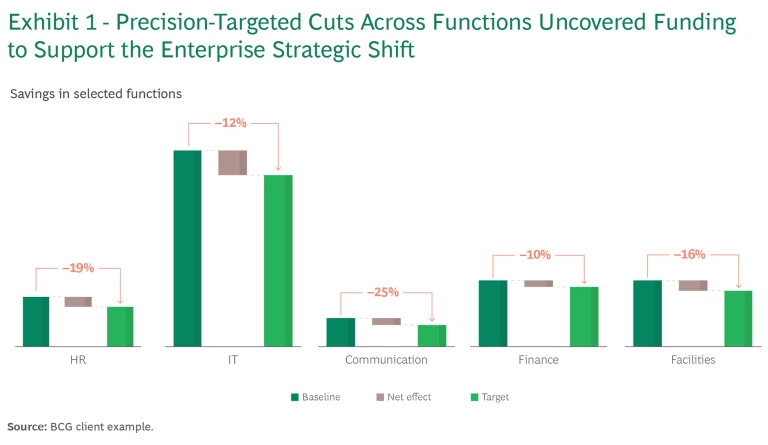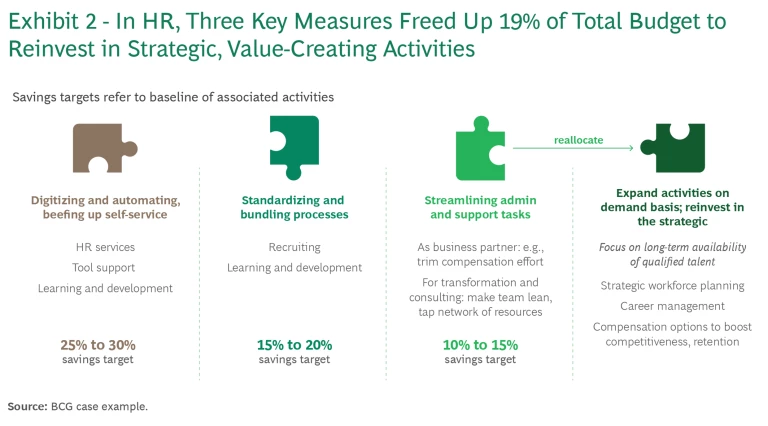“How can I cut costs and still compete for high-priced talent and finance investments in new capabilities and opportunities?” Virtually every business leader today wrestles with this fundamental dilemma. So how do you navigate these financial decisions—especially in a volatile economy—without shortchanging the resources and activities needed for future growth?
With the intense cost pressures of the current environment, you’re undoubtedly scrutinizing people costs more rigorously. Perhaps you’re seeking ways to afford AI talent or offset salary inflation to keep these costs flat. Or trying to reconcile the constant requests to add personnel with the less frequent, but still recurrent, prodding to trim people costs. Maybe you’re struggling to find synergies in the company’s people-cost ratio. If challenges like these seem daunting, the zero-based organization (ZBO) approach—the people-related subset of zero-based transformation—offers some solutions.
The Trouble with Traditional Approaches to Cost Management
Cost management is a top priority among executives, as a recent BCG global survey shows. But successfully reducing costs doesn’t mean those cuts will stick. More than a third of the leaders we surveyed said costs eventually creep back. And more than 25% reported that cutting costs hurts their business, dampens growth, or is simply untethered to the company’s strategy. A major people-cost challenge that companies routinely cite is that while workforce can be reduced, the volume and complexity of work does not change. As a result, the quality of work suffers.
No company can control challenges arising from external forces, such as the macroeconomy, the labor market, or technological advancement. But they can approach these challenges in a smarter way. Important talent and organizational capabilities can easily get sacrificed in the typical “haircut” approach to cost cutting—and at a time when generative AI and other groundbreaking technologies are transforming business , that typical approach can sabotage a company’s ability to compete. Instead of reactive moves, like across-the-board layoffs or budget cuts, companies can differentiate between costs that add value and those that add little or no value. Then, they can identify places to cut and redirect the freed-up resources to meet strategic priorities.
Take data analysis and data mining, for example. Because these are seen as key capabilities, the value of data scientists is obvious. However, the value of, say, performance management professionals may be less apparent. This would make it harder to justify funding these positions, even though they are instrumental to talent retention.
Companies can also differentiate between strategically critical capabilities and activities that should remain in house—and those that can be outsourced more cost-effectively.
Greater Visibility, Better Decision Making
ZBO is a fact-based methodology for reviewing an organization’s resource base. It’s also a cost philosophy, in which the organization essentially establishes a cost baseline from scratch rather than based on historical data or previous cost levels. Working with a cross-disciplinary group—internal customers, experts from the relevant functional areas, and their own team members—cost owners challenge the existing resource base. So instead of being on the receiving end, managers are agents of change. This bottom-up approach ensures that savings are realistic and in sync with business requirements. It also alters the ways of working because people are more invested in cost consciousness —and ZBO companies incentivize this way of thinking. In this way, the approach ensures sustainable change.
By pinpointing cost drivers, ZBO promotes data-driven decision making and infuses objectivity, discipline, and transparency into the resource allocation process. Companies can thus leverage their workforce as effectively and efficiently as possible. ZBO also reduces complexity, supporting faster decision making and action. Most critically, it goes a long way toward solving the problem of having many opportunities to invest, but limited resources.
A Service MVP Is Central to the ZBO Approach
Deploying a ZBO approach entails clarifying cost and value drivers, following a four-step process that produces a minimum viable product (MVP) of services for each activity or process. From this MVP, you build up your resource baseline, adding services that offer a positive ROI. The process is as follows:
Set a cost baseline for each activity.
To get a clear picture of the full costs of an activity, cluster resources by activity, examining people- and people-related costs, whether for internal or external resources. For each activity, look horizontally across organizational borders. For example, finance costs would include not just those of the central finance organization but also those associated with country-level controllers and others beyond corporate headquarters. (It might even include costs overseen by unofficial controllers throughout the business whose efforts often undermine the ability to standardize and optimize processes.)
Pinpoint the company’s ambition.
Senior leadership can use benchmarks and hypotheses about cost levers to determine where the company should land financially in accordance with its strategic ambition and priorities. This deliberate decision is validated through many deep discussions among executives and managers from across the ranks.
Create an MVP for each service.
In this step, current services should be reset to the most skeletal yet functional level before defining an efficient, desired future level. Determine minimum service requirements—those activities either required by law (say, for the finance function , preparing 10-K filings) or essential for operating the business (such as calculating commercial offers). More activities can then be added, but only if you can demonstrate that they produce a positive ROI—such as filling a capability gap.
Challenge the resource baseline.
To identify value, fundamentally rethink existing cost structures. Cost owners and cross-functional teams work together to identify potential opportunities and initiatives, refining the list with the help of a steering committee.
How ZBO Funded an Energy Company’s Shift to Renewables
To appreciate the impact a ZBO program can have, consider the experience of a large European utility conglomerate we worked with that launched its program simultaneously with a major transformation: transitioning from nuclear and fossil-fuel power generation to renewables. This required a substantial investment, and although the company’s business was growing and strategic opportunities were abundant, funds were more limited.
The conglomerate’s support functions were not only costly, they were not organized efficiently to support future growth. They often failed to provide critical services that met the high quality demands of the business. Leaders knew they needed to reduce SG&A spending—but judiciously—in order to generate investment capital for growth. Equally important was fostering a performance culture that would inform daily resource decisions while bolstering internal zero-based proficiency, thus making the impact stick.
Leaders followed the ZBO process, from defining MVPs and imagining the future states to developing an implementation roadmap, complete with initiatives, and pinpointing capability gaps. They tracked the results of the initiatives they launched, conferring with functional experts for guidance on the volume drivers for the service-level contracts with the functional areas, as noted below. (See Exhibit 1.)
- HR developed a new performance contract with the business. For example, it launched digital self-service tools and online training and also standardized and bundled some recruitment processes.
- Finance digitized some processes, cut the frequency of its budgets and forecasts, streamlined closing and annual report activities, outsourced invoicing, and standardized billing and risk management guidelines.
- IT instituted purchasing efficiencies, such as shifting to modern modular systems (which also reduced maintenance costs). It also nearshored mature processes and implemented more self-service applications.

Together, these actions cut total personnel costs by 11% and non-personnel costs by 16%, net of the funds reinvested within the support functions. Achieving 19% savings, HR was able to concentrate on more strategic activities, such as workforce planning and learning and development programs for new capabilities. The IT department realized a significant 12% savings from its multiples-greater resource baseline budget and funneled the investment into insourcing critical activities like analytics, the cloud, and IT architecture. (See Exhibit 2.)

Making the Zero-Based Concept Stick
The ZBO approach requires
new ways of thinking and acting
from everyone in the organization. How do you embed the ZBO practices and policies to produce lasting behavior change? Our recommendations include the following:
- Craft service-level contracts. By formalizing the new service levels with internal customers, the functions lock in the new ways of working that will keep the “fat” out of their budgets.
- Define cost drivers. This allows you to readily see how future business changes might affect the budget. For example, if “number of hires” is the basis for your recruitment budget, HR could only hire more recruiters if it could prove that the number of new company hires will increase. No other variables need be considered, which means budget discussions remain fact-based and straightforward.
- Establish clear accountabilities. Appoint global process owners with a mandate to push improvement across the organization. Create mechanisms such as performance meetings and reports that will help them carry out their role.
- Create operational KPIs. These are essential for tracking performance. Using the HR example, “number of hires per recruiter” would indicate recruiting efficiency.
- Document everything. Behavior change needs to happen in everyday actions. To make it stick, be rigorous in both implementation and execution. Document drivers, milestones, expected savings, responsible parties, and any other relevant details so that the company can track and execute with precision.
- Communicate. Use a variety of channels to explain the ZBO program and its purpose. Reinforce the necessary changes. Broadcast success and celebrate cost-conscious behavior, and highlight the re-investments that are made.
The ZBO approach is not a cost-cutting program in disguise. First and foremost, it is about actively managing and challenging current spending to reinvest for the greatest strategic impact. Companies become not only more capable and future-facing, but leaner and more effective as they relentlessly remove inefficiencies and waste. ZBO is about achieving resource resilience, which allows a company to respond quickly, whether to sudden adversity or newfound opportunity. ZBO helps secure the capabilities and talent a company needs to achieve its strategy in a fast-changing, volatile world. By fostering cost-consciousness, a spirit of cross-organizational cooperation, and a rigorous set of practices, companies gain the transparency, objectivity, and decision-making agility that will get them there.
In the current economic environment, margin pressures are intense, and managing costs is at the top of every C-suite leaders’ to-do list. Deploying a ZBO approach can help your organization today and in the future.










